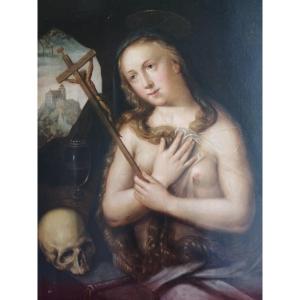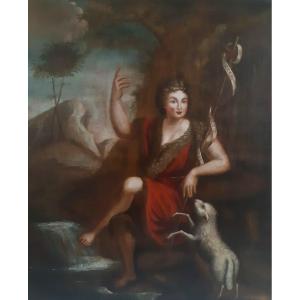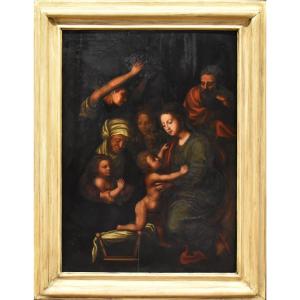This work, dating from the late 16th century, features a dynamic composition and rich colors. In the center, the Virgin Mary, dressed in a dark green robe and a white veil symbolizing purity, contemplates the Infant Jesus lying on a white blanket, a subtle light emanating from him to emphasize his divine nature. Behind her, Saint Joseph, in a red tunic, feeds the donkey, embodying his role as protector. Around them, shepherds in colorful clothing (yellow, red, ochre) are gathered and admire the Newborn. A servant brings a basket of fruit, while animals (a dog, a lamb) enrich the pastoral scene. The background features architectural ruins, symbolizing the end of an ancient era, under a dramatic gray-blue sky. The giltwood frame, carved with scrolls and arabesques, adds a luxurious dimension. Crafted from oak or walnut and gilded with gold leaf over gesso, it reflects late Mannerist or early Baroque techniques, likely of Italian origin (Venice or Rome). Its wear suggests a history of prolonged display, perhaps in a church or private collection.
The pigments used include azurite or smalt for the sky, verdigris and green earth for Mary's robe, vermilion for the reds, and lead white for the light areas. These materials, typical of the period, reflect a workshop mastering traditional techniques.
Dimensions and Condition
Dimensions (without frame): approximately 23 x 18 cm
With frame: approximately 50 x 39 cm
Condition: The painting shows a natural patina; the frame shows partial restorations. This Nativity is part of the late Mannerist period, a transitional period between the Renaissance and the Baroque (1580-1600). Influenced by artists such as Federico Zuccari in Italy, it emphasizes emotion and symbolism, with theatrical poses and contrasting colors. The ruins and divine light evoke Counter-Reformation themes, while the gilded frame reflects the aesthetic of church altarpieces or noble collections. This work testifies to the popular devotion of the period.
Provenance
Provenance uncertain, possibly from a European private collection or a church.
Very careful shipping
#Zuccari #Nativity #ManneristArt #Late16thC #ReligiousPainting #VirginMary #ChristChild #SaintJoseph #Shepherds #GildedFrame #WoodSculpture #RenaissanceArt #FlemishArt #ItalianArt #ArtCollection #AncientArt #ArtHistory #SacredArt #ArtHeritage #ArtSale #ArtPassion
Excerpts from the Visual Expertise of the Artwork:
Analyzing the pigments in a painting like this late 16th-century Nativity can provide valuable clues about artistic techniques, the materials available at the time, and even potential attribution to a specific artist or region. Since this is a visual analysis (and not a direct scientific analysis like spectroscopy or chromatography), I will base my analysis on the colors visible in the image, the artistic practices of the period, and the pigments typically used in the late Renaissance and early Mannerist periods. Here is a detailed study: General Context of Pigments in the 16th Century By the end of the 16th century, European artists were using natural pigments, often of mineral, vegetable, or animal origin, mixed with binders such as oil (especially in Flanders) or tempera (more common in Italy for earlier works). The color palette was limited compared to modern synthetic pigments, but artists mastered the art of creating vibrant and long-lasting hues. Expensive pigments, such as lapis lazuli for blue, were reserved for symbolically important areas (often the Virgin Mary’s mantle), while cheaper pigments, such as earths or ochres, dominated more naturalistic scenes. Analysis of pigments visible in the painting 1. Blue (sky and background) • Observed color: The sky in the background is a pale gray-blue, with subtle hues. • Likely pigments: • Azurite: A copper carbonate (2CuCO₃ Cu(OH)₂) commonly used in the 16th century for blues. Less expensive than ultramarine, it was often used for skies or backgrounds. Its hue ranges from pale blue to blue-green, which corresponds to the shade seen here. • Smalt: A cobalt-tinted glass-based pigment, introduced more widely in the late 16th century, especially in Flanders. It produces a translucent blue-grey, which might also be suitable for this sky. • Natural ultramarine (lapis lazuli): Unlikely here, as this pigment, extracted from the semi-precious stone lapis lazuli, was very expensive and reserved for symbolic areas such as the Virgin’s mantle. The sky in this painting lacks the vibrant depth typical of ultramarine. • Context: Azurite or smalt are consistent with a late 16th-century Mannerist work, especially if it comes from a Flemish workshop or an Italian artist working with less expensive materials. 2. Green (Mary’s robe) • Observed colour: Mary’s robe is a dark green, with deep shadows. • Probable pigments: • Verdigris: A copper acetate-based pigment, often used for greens. It was obtained by controlled oxidation of copper and produced a dark green hue, which was sometimes unstable over time. • Terre verte: A natural mineral pigment (iron silicate), which produces an olive green or gray-green. It was often used as an undercoat or mixed with other pigments to produce richer greens. • Malachite: Another copper carbonate (Cu₂(OH)₂CO₃), more vivid than terre verte, but sometimes used for saturated greens. • Context: The dark green of Mary's dress suggests a likely mixture of terre verte and verdigris, a common combination for producing deep hues. This reflects an economical practice, as Mary is wearing a green here and not the ultramarine blue traditionally associated with her cloak, which could indicate a less fortunate workshop or a different symbolic intention (green being associated with hope and life). 3. Red (Clothing of the Shepherds and Joseph) • Observed Color: Vibrant reds appear in the clothing of the shepherds and Saint Joseph, ranging from an orange-red to a deeper red. • Likely Pigments: • Vermilion: A mercury sulfide (HgS), which produces a bright orange-red. Very popular in the 16th century, it was used for bright colors in clothing. • Madder Lake: An organic pigment extracted from the madder plant (Rubia tinctorum), which produces deeper, warmer reds. Often used for glazes or mixed with other reds. • Minium: A lead oxide (Pb₃O₄), which produces an orange-red, sometimes used as an undercoat or mixed to adjust tones. • Context: Vermilion is the most likely candidate for the bright reds in clothing, especially those of the shepherds. Madder lake could have been used for darker shades or for glazes giving depth. These pigments were widely available in Europe at that time and correspond to a Mannerist palette. 4. White (Mary's veil, Jesus' blanket) • Observed color: White areas, such as Mary's veil and the Baby Jesus' blanket, are luminous with subtle shadows. • Probable pigments: • Umber: A natural pigment made from iron and manganese oxide, which produces warm to cool browns depending on its preparation. • Carbon black or bone black: Used to darken shadows or create grays when mixed with lead white. • Context: Umbers were basic pigments for naturalistic scenes, often mixed to create variations of brown and gray. The contrast between the dark ruins and the bright figures is typical of Mannerist compositions. Probable techniques • Support and medium: The painting appears to be on copper, a common practice in the 16th century, especially in Flanders. The medium is oil, which allows for subtle glazing and transitions, as seen in the shadows and drapery. • Layering: Artists of the period applied underpaintings (often with earths or lead white) before laying down the main colors. The bright areas, such as Mary’s veil, show a probable use of thick lead white, while the shadows were created with glazes of transparent pigments (umber, madder lake). • Lighting effects: The light around Jesus is probably achieved by successive layers of lead white and clear glazes, a Mannerist technique to suggest divinity. Clues to origin and artist • Use of economical pigments: The dominant ochres, earths, and verdigris point to an artist or workshop working with common materials, such as Maarten de Vos or Federico Zuccari. • Vibrant but controlled palette: The rich but not overly saturated palette is typical of late Mannerism, consistent with artists such as Taddeo or Federico Zuccari in Italy, or Bartholomeus Spranger in a Flemish context. The openwork carved and gilded wooden frame surrounding this Nativity painting offers valuable clues about its origin, period of creation, and cultural context, complementing the analysis of the work itself. Here is a detailed analysis based on its visual appearance and late 16th-century artistic practices: General Description The frame is richly ornamented, with a rectangular structure adorned with relief-carved motifs. The decorations feature asymmetrical volutes and arabesques, typical of late Baroque or Mannerist styles, with floral elements and elaborate curves. The gilding, probably applied with gold leaf, gives an impression of luxury and prestige. The upper part of the frame includes more pronounced ornamentation, perhaps some kind of cartouche or stylized shield, suggesting a decorative intention or a heraldic symbol. The wood is partially visible beneath the gilding, with signs of wear, indicating an old or restored piece. Materials and Techniques Wood: The choice of wood is essential for a carved frame. By the end of the 16th century, woods like oak (common in Northern Europe) or walnut (more commonly used in Italy) were favored for their durability and ability to be finely worked. The wood is solid, suggesting quality craftsmanship.Gilding: Gold leaf, applied over a preparation of gesso (a mixture of plaster and glue) and bol (red clay), was a standard technique for frames of this period. This method produced a glossy, luxurious finish, often reserved for religious works or commissions for churches, convents, or noble families.Openwork carving: Cut-out designs (openwork) indicate expertise in joinery and wood carving. This technique, where portions of the wood are removed to create openings, was common in Mannerist or early Baroque frames, allowing for visual lightness while accentuating decorative richness. Style and Dating Mannerist and Early Baroque Influence: The intricate scrollwork and arabesques, combined with subtle asymmetry, are part of the Late Mannerist (late 16th century) or Early Baroque (early 17th century) styles. This style is particularly associated with Italy (especially the Venice area or Rome) and Flanders, where craftsmen competed to embellish the frames of religious works. Probable Period: Although the painting is dated to the late 16th century, the frame could be slightly later, dating to the early 17th century. Frames were often added or replaced over time to adapt a work to new tastes or contexts (for example, when it was moved to a church or private collection). Wear to the gilding and traces of restoration suggest a long history of use...




































 Le Magazine de PROANTIC
Le Magazine de PROANTIC TRÉSORS Magazine
TRÉSORS Magazine Rivista Artiquariato
Rivista Artiquariato